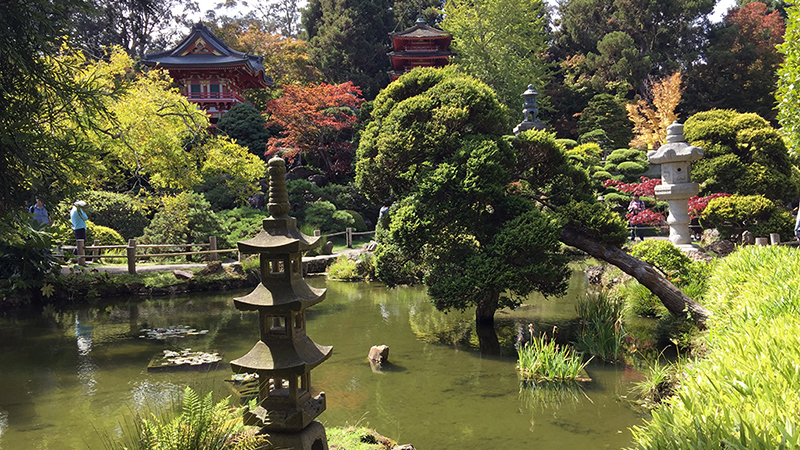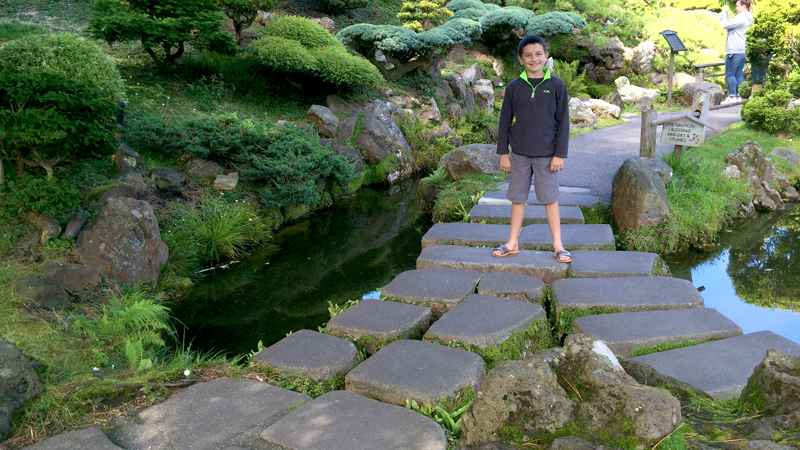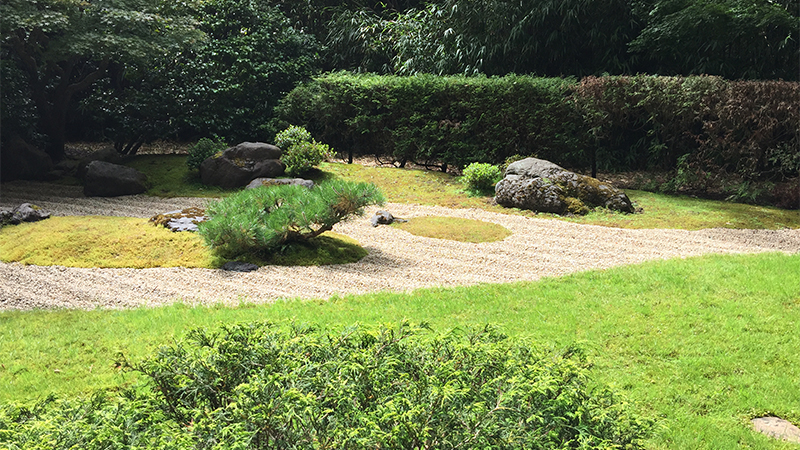
After spending the morning exploring the California Academy of Sciences, we grabbed some lunch from the food trucks parked behind the Spreckels Temple of Music at the west end of the Golden gate Park Music Concourse, and then walked over to the Japanese Tea Garden.
Throughout my life, I’ve probably been to the San Francisco Japanese Tea Garden ten times. The last time I visited the park though was before we had kids, so I was up for another visit. Plus, Natalie and Carter wanted to check it out too, especially after I told them about the awesome Drum Bridge.
The Drum Bridge was my favorite part of the whole garden as a child. It’s actually the one element I remember the most. The Drum Bridge is a beautiful, very steep, half-circle bridge over a serene pool of water that is shaped like half of a drum. When viewing the bridge from a distance, the reflection in the water creates a full circle. While the bridge is totally impractical in everyday life, it makes for a fantastic photo opportunity. The two towering, bold, red and black pagodas set against a garden of lush green plants also make for stunning photographic backgrounds.
Without stopping to meditate, enjoy a cup of tea, or relax in the garden, walking through the entire Japanese Tea Garden only takes 30 minutes to an hour.

Touring The Japanese Tea Garden
If you’re planning a trip to the Japanese Tea Garden in Golden Gate Park, try to visit during the week or first thing in the morning. On Mondays, Wednesdays, and Fridays, admission is free if you enter the park before 10:00 am.
We visited the garden on a Saturday afternoon and crowded doesn’t even come close to describing how packed the park was with people.
Every time I went to take a photo, I ended up taking photos of people taking photos, or waiting sometimes 10-15 minutes for people to move out of the way. There were hoards of people everywhere. The wait at the tea house was over an hour long, throughout the park we were stuck behind other people, and the noise level was exactly the opposite of what you want to experience at a garden that is supposed to be peaceful and zen-like. And don’t even get me started on the large group of people who basically took over the Drum Bridge for almost an hour. It was an extended family group who took their time ushering various family members slowly up and down the bridge, while they took photos of every possible combination of people, without a single care for other park visitors.
Needless to say, the gardens aren’t that enjoyable, peaceful, or zen-like on a weekend afternoon.

History of The Japanese Tea Garden
The Japanese Tea Garden at Golden Gate Park, in San Francisco, California is the oldest public Japanese garden in the United States.
Originally created as a “Japanese Village” exhibit for the 1894 California Midwinter International Exposition, the site originally spanned about one acre and showcased a Japanese style garden. When the fair closed, Japanese landscape architect Makoto Hagiwara, with permission from John McLaren, transformed the temporary exhibit into a permanent Japanese garden. Between 1895 and 1942, Hagiwara and his family lived on the property, as he designed and developed the meticulously landscaped Japanese Tea Garden.
His efforts expanded the garden to its current size of approximately 5 acres. He imported authentic tributes to his homeland, including rare Japanese birds, goldfish, bronze items, and plants, and the new garden was also decorated with an assortment of appealing statues, such as a wooden Buddha, a Shinto Shrine, stately eagles with spread wings, and a porcelain lantern.
In 1942, Makoto Hagiwara and his family, along with approximately 120,000 Japanese Americans, were forced to evacuate their homes and move into internment camps. The garden was then given the name “The Oriental Tea Garden.” During wartime, many of the beautiful arrangements were destroyed or removed, sculptures vanished, and many plants succumbed from lack of care. In 1952, the garden was officially renamed the Japanese Tea Garden once more, and in 1953, a 9,000 pound Japanese offering called the Lantern of Peace was placed on the premises in an effort to ease the tensions associated with the past.
Today, the Japanese Tea Garden provides visitors from around the world with an opportunity to experience the natural beauty, tranquility, and harmony of a Japanese-style garden in the heart of San Francisco’s Golden Gate Park. Visitors can see a few elements from the original Japanese gardens, including the tea house (Ochaya), the Monterey pine located by the Main Gate, and the Drum Bridge (Taiko Bashi). New features have also been added, including stone lanterns, statues, cherry blossom trees, koi ponds, stepping stone paths, native Japanese plants, a waterfalls, a zen garden, and two pagodas — one that once graced the 1915 Japanese exhibit at the Panama-Pacific Exposition.
The Fortune Cookie Story
Apparently, the Japanese Tea Garden in San Francisco was the first place in the whole world to serve fortune cookies.
According to family members, Mr. Hagiwara introduced fortune cookies to the United States from Japan in the 1890’s or early 1900’s. This fact was actually disputed and the Japanese Tea Garden won during a hearing by the San Francisco Court of Historical Review.
Initially, the cookies were made on site by hand using a special iron mold or kata. When demand grew, Mr. Hagiwara hired San Francisco confectioner Benkyodo to produce the fortune cookies in large quantities. Original fortune cookies made in Japan were savory rather than sweet, and it is believed that Benkyodo developed a vanilla recipe for Mr. Hagiwara to make it more appealing to Western palates, the flavor that is now widely popular across the U.S.
The tradition of serving fortune cookies to Tea Garden visitors continues today; one is tucked inside every bowl of Japanese rice crackers or arare sold at the Tea House.
Know Before You Go
- The Japanese Tea Garden and Tea House is located at 75 Hagiwara Tea Garden Drive, San Francisco, California 94118. The garden is in Golden Gate Park, east of Stow Lake, between John F. Kennedy Drive and Martin Luther King, Jr. Drive.
- The garden is open daily with no holiday closures. Summer hours (3/1 through 10/31) are 9:00 am to 6:00 pm. Winter hours (11/1 through 2/28) are 9:00 am to 4:45 pm.
- Admission fees are $8.00 for adults, $6.00 for seniors and youth, and $2.00 for children. Children 4 and under are free. Discount pricing is available for residents. Admission to the garden is free when entering before 10:00 am on Monday, Wednesday, and Friday.
- Inside the garden, is a small Asian Art Museum and Gift Shop selling authentic Japanese items including tea and sake sets, glazed ceramic bowls and vases, kokeshi and daruma dolls, a variety of green teas, maneki neko figurines, and children’s collectibles.
- For the full experience, enjoy a cup of tea and Japanese refreshments in the Tea House located in the center of The Japanese Tea Garden.
- Muni offers connections to the park throughout the city. Parking is available in the Music Concourse Parking Facility and street parking is located throughout Golden Gate Park.














